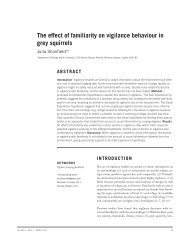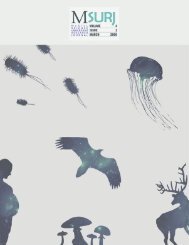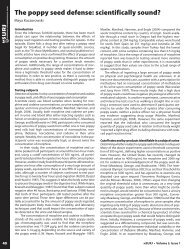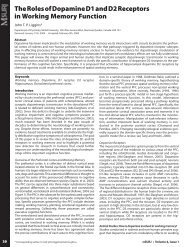the entire issue - McGill Science Undergraduate Research Journal ...
the entire issue - McGill Science Undergraduate Research Journal ...
the entire issue - McGill Science Undergraduate Research Journal ...
You also want an ePaper? Increase the reach of your titles
YUMPU automatically turns print PDFs into web optimized ePapers that Google loves.
RESEARCH ARTICLE<br />
The effect of Eurosta solidaginis parasitism on<br />
pollinator preference in Solidago canadensis<br />
Adam Meyer 1 *, Natasha Salter 1 , Stephanie Shooner 1<br />
All authors contributed equally to this work<br />
1<br />
Department of Biology, <strong>McGill</strong> University, Montreal, QC<br />
*Email Correspondence:<br />
gregory.meyer2@mail.mcgill.ca<br />
Abstract<br />
Solidago canadensis is a self-incompatible perennial species indigenous to North America that reproduces<br />
asexually via rhizomes and sexually via seeds. It is <strong>the</strong> favoured host of <strong>the</strong> gall fly, Eurosta solidaginis. Sexual<br />
reproduction leads to faster rates of adaptation in stressful environments and may be advantageous in <strong>the</strong><br />
maintenance of host-parasite coevolution. The effect of infection by <strong>the</strong> gall fly on pollinator visitations<br />
at <strong>the</strong> patch and at <strong>the</strong> ramet level was assessed as a proxy for <strong>the</strong> ability to sexually reproduce. The<br />
study was conducted by analyzing pollinator preference at both <strong>the</strong> patch level and individual ramet<br />
level through successive observations of pollinator visitations. Though <strong>the</strong> variation in <strong>the</strong> number of<br />
pollinator visitations could be accounted for by time of day and median bloom stage, <strong>the</strong> percentage of<br />
infected ramets in a patch was not a significant explanatory variable. This suggests that gall formation does<br />
not affect pollinator preference and that <strong>the</strong> capacity to sexually reproduce is likely not reduced because<br />
of <strong>the</strong> host-parasite interaction. Broadly, this study served as an example of how pollinator preference<br />
may be utilized as a measure of fitness, and to fur<strong>the</strong>r understand how selective pressures affect plant<br />
populations that reproduce both sexually and asexually.<br />
Introduction<br />
Solidago canadensis, <strong>the</strong> Canada Goldenrod, is a perennial species indigenous<br />
to North America that reproduces asexually via rhizomes<br />
and sexually via seeds. It colonizes abandoned fields and after one<br />
year of seedling growth it begins to reproduce vegetatively, extending<br />
out from <strong>the</strong> centre to form a circular clone. The ability to reproduce<br />
both sexually and asexually raises interesting questions as<br />
to how <strong>the</strong> plant responds to environmental stresses. For example,<br />
<strong>the</strong>re is evidence that goldenrod clonal colonies (genets) can share<br />
resources among ramets (any stem belonging to <strong>the</strong> genet), but it is<br />
unclear whe<strong>the</strong>r a given stress to an individual ramet is indeed detrimental<br />
to <strong>the</strong> <strong>entire</strong> genet (1). One such stress is parasitization by<br />
<strong>the</strong> gall fly Eurosta solidaginis, which is responsible for <strong>the</strong> formation<br />
of stem ball-galls on <strong>the</strong> plant.<br />
In <strong>the</strong> early summer, female gall flies oviposit <strong>the</strong>ir eggs in <strong>the</strong> developing<br />
leaves of S. canadensis; when <strong>the</strong> larvae hatch, <strong>the</strong>y migrate to<br />
<strong>the</strong> meristem t<strong>issue</strong> and induce <strong>the</strong> formation of a gall. The stem continues<br />
to grow above <strong>the</strong> gall (2). As McCrea and Abrahamson (1985)<br />
demonstrate, <strong>the</strong>re may be significant physiological and reproductive<br />
detriments to individual ramets with little to no perceived damage to<br />
<strong>the</strong> genet as a whole (1). For example, ramets infected by gallmaking<br />
parasitic insects have been found to allocate less energy resources<br />
towards both seed production and rhizome extensions (2), and devote<br />
an appreciable amount of energy to producing <strong>the</strong> gall, to <strong>the</strong><br />
detriment of <strong>the</strong> ramet (3). Though effects to genet fitness remains<br />
apparently low, it has been suggested that if a significant number<br />
of damaged ramets were present within <strong>the</strong> genet, this may be sufficient<br />
to decrease <strong>the</strong> fitness of <strong>the</strong> whole (1). Fur<strong>the</strong>rmore, <strong>the</strong> fact<br />
that gall infections affect sexual reproduction in S. canadensis more<br />
than asexual reproduction (1), creates <strong>the</strong> possibility of selection for<br />
resistance to gallmaking insects.<br />
Since S. canadensis is self-incompatible, outcrossing mediated by pollinators<br />
such as honeybees, bumblebees, soldier beetles and syrphid<br />
flies is obligatory for sexual reproduction (2). If differential resource<br />
allocation due to infection decreases <strong>the</strong> attractiveness of <strong>the</strong> clone<br />
to pollinators, <strong>the</strong>reby reducing its sexual reproductive success, <strong>the</strong>n<br />
this genotype may be excluded from <strong>the</strong> population in favour of a<br />
parasite-resistant genotype. Through <strong>the</strong> sexual reproductive success<br />
of more resistant genotypes, S. Canadensis is both more likely to<br />
evolve resistance against parasites, and evolve resistance at faster<br />
rates. On <strong>the</strong> o<strong>the</strong>r hand, if <strong>the</strong> rate of cross-pollination is not affected<br />
by <strong>the</strong> presence of <strong>the</strong> parasite <strong>the</strong>n population resistance<br />
may evolve more slowly compared to <strong>the</strong> rate of increased virulence<br />
of <strong>the</strong> parasite.<br />
In order to better understand <strong>the</strong> effects of E. solidaginis on goldenrod<br />
evolution we focused on <strong>the</strong> plant’s ability to attract pollinators.<br />
24<br />
<strong>McGill</strong> <strong>Science</strong> <strong>Undergraduate</strong> <strong>Research</strong> <strong>Journal</strong> - msurj.mcgill.ca









